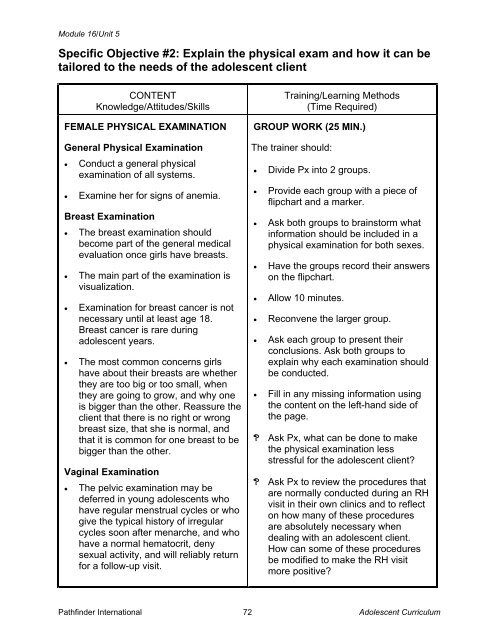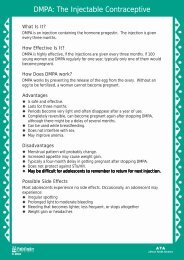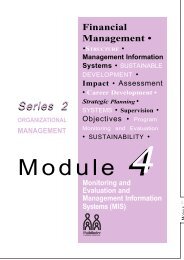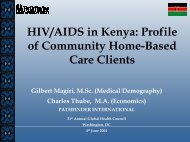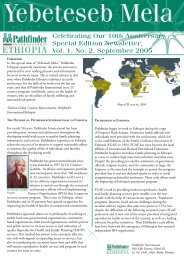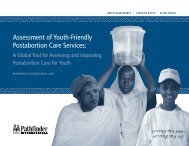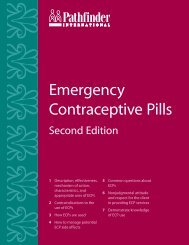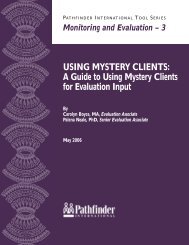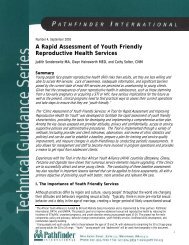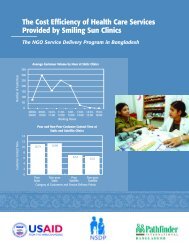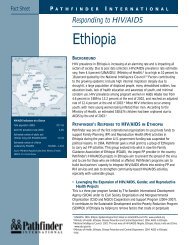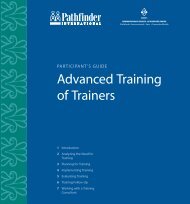reproductive health services for adolescents - Pathfinder International
reproductive health services for adolescents - Pathfinder International
reproductive health services for adolescents - Pathfinder International
Create successful ePaper yourself
Turn your PDF publications into a flip-book with our unique Google optimized e-Paper software.
Module 16/Unit 5<br />
Specific Objective #2: Explain the physical exam and how it can be<br />
tailored to the needs of the adolescent client<br />
CONTENT<br />
Knowledge/Attitudes/Skills<br />
FEMALE PHYSICAL EXAMINATION<br />
General Physical Examination<br />
• Conduct a general physical<br />
examination of all systems.<br />
• Examine her <strong>for</strong> signs of anemia.<br />
Breast Examination<br />
• The breast examination should<br />
become part of the general medical<br />
evaluation once girls have breasts.<br />
• The main part of the examination is<br />
visualization.<br />
• Examination <strong>for</strong> breast cancer is not<br />
necessary until at least age 18.<br />
Breast cancer is rare during<br />
adolescent years.<br />
• The most common concerns girls<br />
have about their breasts are whether<br />
they are too big or too small, when<br />
they are going to grow, and why one<br />
is bigger than the other. Reassure the<br />
client that there is no right or wrong<br />
breast size, that she is normal, and<br />
that it is common <strong>for</strong> one breast to be<br />
bigger than the other.<br />
Vaginal Examination<br />
• The pelvic examination may be<br />
deferred in young <strong>adolescents</strong> who<br />
have regular menstrual cycles or who<br />
give the typical history of irregular<br />
cycles soon after menarche, and who<br />
have a normal hematocrit, deny<br />
sexual activity, and will reliably return<br />
<strong>for</strong> a follow-up visit.<br />
Training/Learning Methods<br />
(Time Required)<br />
GROUP WORK (25 MIN.)<br />
The trainer should:<br />
• Divide Px into 2 groups.<br />
• Provide each group with a piece of<br />
flipchart and a marker.<br />
• Ask both groups to brainstorm what<br />
in<strong>for</strong>mation should be included in a<br />
physical examination <strong>for</strong> both sexes.<br />
• Have the groups record their answers<br />
on the flipchart.<br />
• Allow 10 minutes.<br />
• Reconvene the larger group.<br />
• Ask each group to present their<br />
conclusions. Ask both groups to<br />
explain why each examination should<br />
be conducted.<br />
• Fill in any missing in<strong>for</strong>mation using<br />
the content on the left-hand side of<br />
the page.<br />
Ask Px, what can be done to make<br />
the physical examination less<br />
stressful <strong>for</strong> the adolescent client<br />
Ask Px to review the procedures that<br />
are normally conducted during an RH<br />
visit in their own clinics and to reflect<br />
on how many of these procedures<br />
are absolutely necessary when<br />
dealing with an adolescent client.<br />
How can some of these procedures<br />
be modified to make the RH visit<br />
more positive<br />
<strong>Pathfinder</strong> <strong>International</strong><br />
72<br />
Adolescent Curriculum


